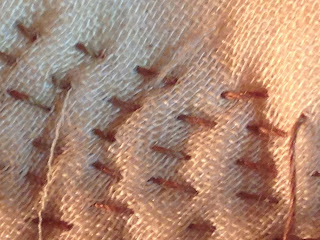The other day, my friend Manisha, posted this comment as her
status on facebook:
[20th June 2013]
........dear men of
the World.what is it that propels you to such aggression...is it just
patriarchy????...from glitzy Hollywood to our own shores.........for a while I
shall avoid asking ''what right do you have to do so?"
[I have reprinted it exactly as she wrote it,
spelling mistakes included]
It was late in the evening when I read it and soon
after, I picked up my embroidery. I kept thinking about what she had said. I
could not dismiss it. I too have been in relationships that have been abusive
and violated my sense of self in physical and emotional ways and I could
understand where she was coming from. It allowed me to feel my rage too. Does
it happen to all women? Is it about self-respect or lack of it? And what does
one do when one has been through such experiences? The newspapers report some
crime or other each day. Rape, murder, terror and even the recent flooding in
Uttarakhand is no less violent, is it?
 With these thoughts circling my mind, I kept sewing. Needle
in, pull the thread, needle out, going round and around, tracing the stains
with a running stitch. And then I realized that using the needle could also be considered
an act of violence. The fabric is mute, it does not protest and just like I
made the stains, it seemed that I was subjecting the fabric through the act of stitching,
of piercing it again and again with the point of this sharp instrument, to
another kind of violence. I looked at this long, slender tool, held between my
thumb and forefinger, its pointed tip poised to strike again, waiting to lunge
forth into the fabric, at my command.
With these thoughts circling my mind, I kept sewing. Needle
in, pull the thread, needle out, going round and around, tracing the stains
with a running stitch. And then I realized that using the needle could also be considered
an act of violence. The fabric is mute, it does not protest and just like I
made the stains, it seemed that I was subjecting the fabric through the act of stitching,
of piercing it again and again with the point of this sharp instrument, to
another kind of violence. I looked at this long, slender tool, held between my
thumb and forefinger, its pointed tip poised to strike again, waiting to lunge
forth into the fabric, at my command.
I stared at it long and hard. It was after all a
perpetrator of violence – a criminal like all the men who raped and abused and
those who killed, and mother nature herself was not beyond it too. As they say when
someone is cruel – what kind of person are you, what are you made of? I have no
idea what the needle is made of. I asked it the same question: what are you
made of? I looked on the
packaging for some clues, but there was no mention of materials used.
Needles have been
around for a long time and sewing in the subcontinent dates back to
the Indus Valley civilization - needles have been excavated at
Mohenjodaro. I quickly did some research and learned that the first needles
were apparently made of bone or wood while the modern ones are made using high
carbon steel wire which is nickel or 18 carat gold plated to minimize corrosion
resistance. The highest quality embroidery needles are apparently plated with
two-thirds platinum and one-third titanium alloy. They are tough and pierce
through fabric without bending or losing shape - without any kind of compassion
it seems.
I had never
thought of sewing as a violent activity but as I continued with my embroidery, I
learned something.
The layers of
fabric in my hands had been subjected to considerable violence. I had burned it.
I had shred it and had then stitched these layers with needle and thread,
piercing through the warp and weft, tearing the very fabric asunder. But the
miracle of stitch is that the needle may wound, the needle may pierce and tear,
but the thread it carries, keeps it all together – embellishing the fabric it
wounds.
 If one considers
how beautiful embroidery can be and how much this art is used to embellish our
clothes and homes, then the needle doesn’t just wound or violate, it provides
for another dimension to be added to the fabric. If one could extend this to
the human fabric, could one begin to look at acts of violation as opportunities
that add something of value to the fabric of being?
If one considers
how beautiful embroidery can be and how much this art is used to embellish our
clothes and homes, then the needle doesn’t just wound or violate, it provides
for another dimension to be added to the fabric. If one could extend this to
the human fabric, could one begin to look at acts of violation as opportunities
that add something of value to the fabric of being?
Something to
think about.....?



















